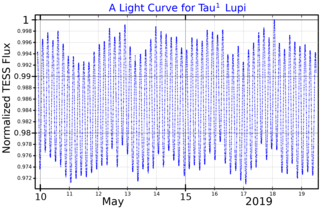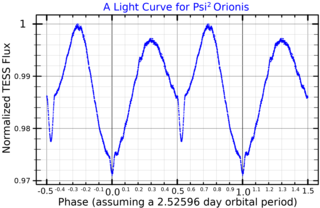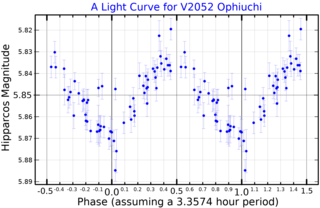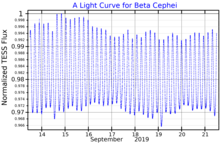
Beta Centauri is a triple star system in the southern constellation of Centaurus. It is officially called Hadar. The Bayer designation of Beta Centauri is Latinised from β Centauri, and abbreviated Beta Cen or β Cen. The system's combined apparent visual magnitude of 0.61 makes it the second-brightest object in Centaurus and the eleventh brightest star in the night sky. According to parallax measurements from the astrometric Hipparcos satellite, the distance to this system is about 390 light-years.

Beta Canis Majoris, also named Mirzam, is a star in the southern constellation of Canis Major, the "Great Dog", located at a distance of about 500 light-years (150 parsecs) from the Sun. In the modern constellation it lies at the position of the dog's front leg.

Gamma Pegasi is a star in the constellation of Pegasus, located at the southeast corner of the asterism known as the Great Square. It has the formal name Algenib ; the Bayer designation Gamma Pegasi is Latinized from γ Pegasi and abbreviated Gamma Peg or γ Peg. The average apparent visual magnitude of +2.84 makes this the fourth-brightest star in the constellation. The distance to this star has been measured using the parallax technique, yielding a value of roughly 470 light-years.

Zeta Canis Majoris, or ζ Canis Majoris, also named Furud, is a binary star system in the southern constellation of Canis Major. This system has an apparent visual magnitude of +3.0, making it one of the brighter stars in the constellation and hence readily visible to the naked eye. Parallax measurements from the Hipparcos mission yield a distance estimate of around 362 ly (111 pc) from the Sun. It is drifting further away with a radial velocity of +32 km/s.

Iota Canis Majoris, Latinized from ι Canis Majoris, is a solitary variable supergiant star in the southern constellation of Canis Major. It is visible to the naked eye with an apparent visual magnitude that varies between +4.36 and +4.40. The distance to this star is approximately 3,100 light years based on parallax measurements. It is drifting further away with a radial velocity of +41.2 km/s.

Xi1 Canis Majoris, Latinized from ξ1 Canis Majoris, is a Beta Cephei variable star in the constellation Canis Major. It is approximately 1,400 light years from Earth.

15 Canis Majoris is a variable star in the southern constellation of Canis Major, located roughly 1,200 light years away from the Sun. It has the variable star designation EY Canis Majoris; 15 Canis Majoris is the Flamsteed designation. The star is visible to the naked eye as a faint, blue-white hued star with a baseline apparent visual magnitude of +4.82. It is moving away from the Earth with a heliocentric radial velocity of 28 km/s.

27 Canis Majoris is a binary star system in the northern constellation of Canis Major, located approximately 1,700 light years away from the Sun. It has the variable star designation EW Canis Majoris; 27 Canis Majoris is the Flamsteed designation. This system is visible to the naked eye as a dim, blue-white hued star with an apparent visual magnitude of +4.65. It is moving away from the Earth with a heliocentric radial velocity of 16 km/s.
Alpha Cygni variables are variable stars which exhibit non-radial pulsations, meaning that some portions of the stellar surface are contracting at the same time other parts expand. They are supergiant stars of spectral types B or A. Variations in brightness on the order of 0.1 magnitudes are associated with the pulsations, which often seem irregular, due to beating of multiple pulsation periods. The pulsations typically have periods of several days to several weeks.

DL Crucis is a variable star in the constellation Crux.

Omega1 Cygni, Latinized from ω1 Cygni, is the Bayer designation for a solitary star in the northern constellation of Cygnus. It is visible to the naked eye with an apparent visual magnitude of 4.94. Based upon an annual parallax shift of 2.59 mas, it is estimated to lie roughly 1,260 light years from the Sun. Relative to its neighbors, this star has a peculiar velocity of 25.7±2.2 km/s.

Nu Eridani is a star in the constellation Eridanus. It is visible to the naked eye with an apparent visual magnitude of 3.93. The distance to this star is roughly 520 light years, based upon an annual parallax shift of 0.00625 arcseconds. If the star were 33 ly (10 pc) from the Sun, it would be the brightest star in the night sky with an apparent magnitude of −2.84.

Tau1 Lupi, Latinized from τ1 Lupi, is a solitary star in the southern constellation of Lupus. It is visible to the naked eye with an apparent visual magnitude of 4.5. Based upon an annual parallax shift of only 2.99 mas as seen from Earth, it is located about 1,090 light years from the Sun. Tau1 Lupi may be a runaway star having a peculiar velocity of 32.6±3.6 km/s. It is a member of the Upper Centaurus–Lupus sub-group of the nearby Sco OB2 association.

HD 54893, often called A Puppis is a suspected variable star in the constellation Puppis. Its apparent magnitude is 4.83 and is approximately 860 light years away based on parallax.

BW Vulpeculae or BW Vul, is a variable star in the northern constellation of Vulpecula. It is near the lower limit of visibility to the naked eye with a typical apparent visual magnitude of 6.54. Based on an annual parallax shift of 1.15 mas, the distance to BW Vul is about 2,800 light years. It is moving closer to the Earth with a baseline heliocentric radial velocity of around −6 km/s.

FN Canis Majoris is a binary star system in the southern constellation Canis Major, near the northern constellation border with Monoceros. It is dimly visible to the naked eye with a combined apparent visual magnitude of 5.41. The system is located at a distance of approximately 3,000 light years from the Sun based on parallax, and is drifting further away with a radial velocity of +31 km/s. It is a runaway star associated with the Sh 2-296 nebula in the CMa OB1 association, and has a conspicuous bow-shock feature.

Psi2 Orionis a binary star system in the equatorial constellation of Orion. It has an apparent visual magnitude of 4.6, indicating that it is visible to the naked eye. Based upon an annual parallax shift of 2.87 mass, it is roughly 1,100 light years distant from the Sun.

12 Lacertae is a wide binary star system in the northern constellation of Lacerta, located roughly 1,260 light years away from the Sun based on parallax. It is visible to the naked eye as a dim, blue-white hued point of light with a baseline apparent visual magnitude of 5.23. The system is drifting closer to the Earth with a mean heliocentric radial velocity of –12.5. It is a probable member of the I Lacertae OB association.

FG Virginis is a well-studied variable star in the equatorial constellation of Virgo. It is a dim star, near the lower limit of visibility to the naked eye, with an apparent visual magnitude that ranges from 6.53 down to 6.58. The star is located at a distance of 273.5 light years from the Sun based on parallax measurements, and is drifting further away with a radial velocity of +16 km/s. Because of its position near the ecliptic, it is subject to lunar occultations.

V2052 Ophiuchi, also known as HR 6684, is a star about 920 light years from Earth in the constellation Ophiuchus. It is a 5th-magnitude star, making it faintly visible to the naked eye of an observer far from city lights. V2052 Ophiuchi is a Beta Cephei variable star, varying slightly in brightness from magnitude 5.81 to 5.84 over a period of about 3.4 hours.

















